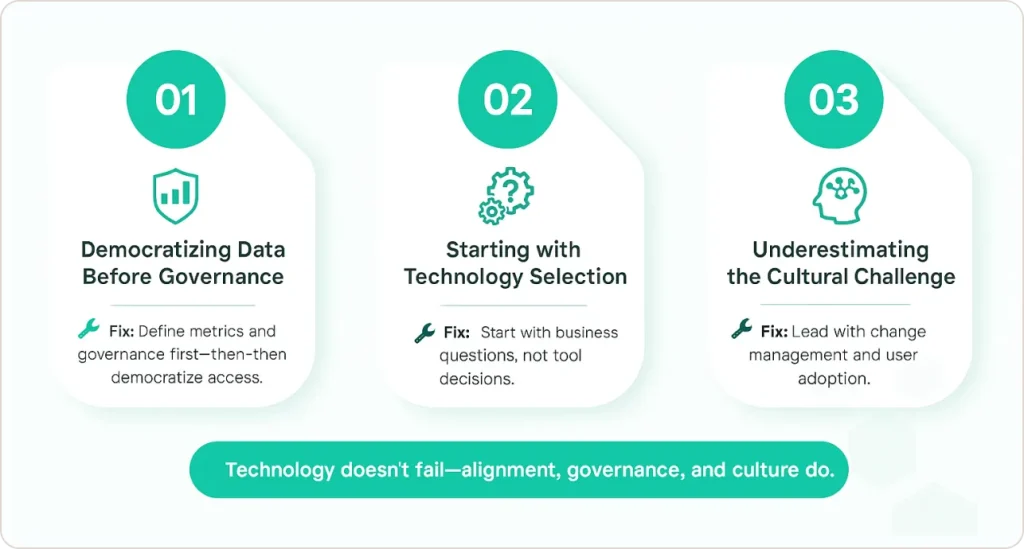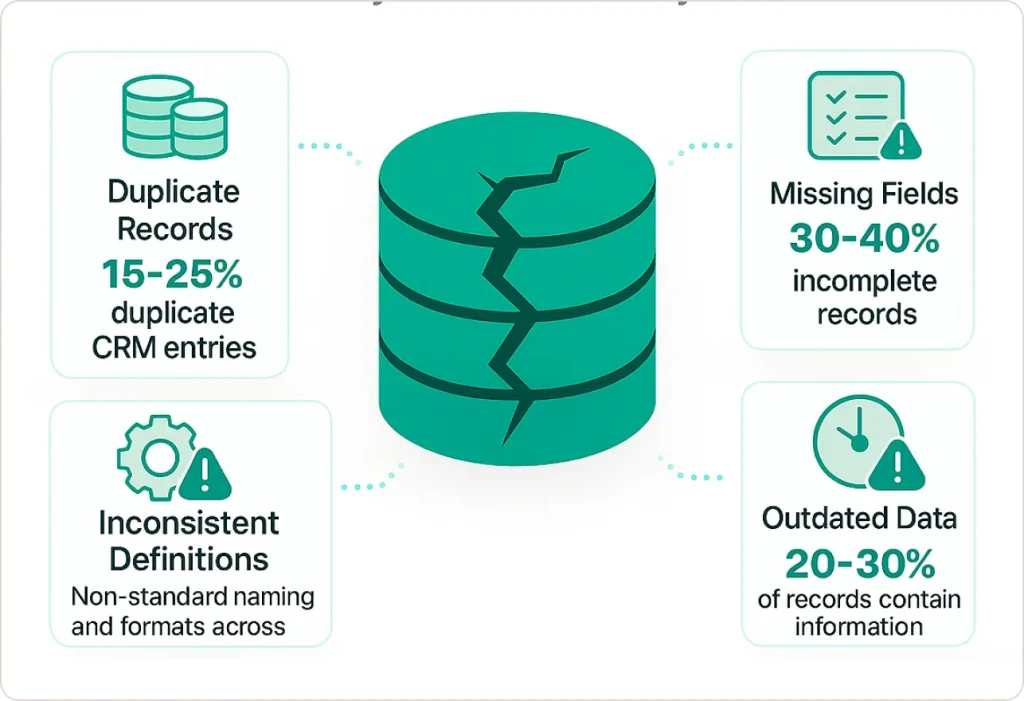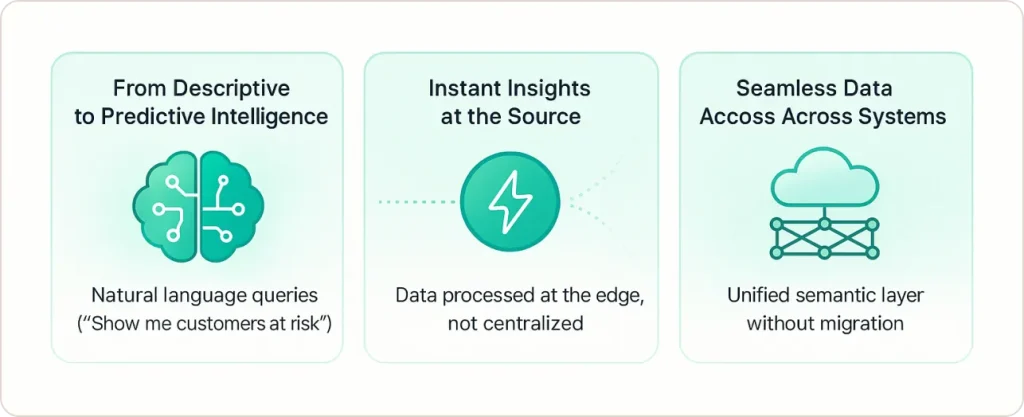Key Highlights:
- Companies with mature BI make decisions 5x faster than competitors
- Strategic BI implementation delivers average 340% ROI in first year
- 70% of BI projects fail due to cultural and governance gaps
- Industry-specific BI frameworks accelerate transformation by 18+ months
- Discovery-first methodology prevents costly false starts
Introduction: Why Smart Companies Are Pulling Ahead
Your competitors make decisions in hours. You’re still waiting for monthly reports.
I’m going to tell you something most BI consultants won’t admit: your digital transformation is probably failing right now, and you don’t even know it yet.
Over the past 20 years and 50,000+ consulting hours across healthcare systems, manufacturers, financial institutions, and e-commerce companies, I’ve watched the same pattern repeat: Organizations invest millions in cloud migrations, automation platforms, and modern applications. They generate more data than ever before. But they’re not making better decisions. They’re not moving faster. They’re certainly not seeing the ROI they expected.
Here’s what I’ve learned: The role of business intelligence isn’t just important to digital transformation—it’s the only thing that determines whether transformation succeeds or becomes another write-off.
Think about it: Your competitors are adjusting pricing in real-time based on demand signals. You’re waiting for quarterly reports. They’re predicting equipment failures 72 hours in advance. You’re dealing with unexpected downtime. They’re personalizing customer experiences based on behavioral data. You’re still segmenting by demographics.
The gap isn’t technology. It’s intelligence.
The importance of business intelligence has evolved from “nice to have reporting” to “existential competitive necessity.” And most organizations are getting it catastrophically wrong—not because they lack tools, but because they’re asking the wrong questions and following the wrong implementation playbook.
Why BI Projects Fail (And How to Fix It)

The Three Fatal Mistakes
Fatal Mistake #1: Democratizing Data Before Establishing Governance
Everyone loves the idea of “data democratization”—giving everyone access to insights. But here’s what actually happens when you democratize bad data:
I worked with a $400M manufacturer that rolled out Power BI to 200+ employees before establishing data definitions. Within three months, they had 47 different calculations for “gross margin,” 23 definitions of “customer,” and executives making contradictory decisions based on conflicting dashboards.
The fix: Governance first, access second. Define your metrics, establish a single source of truth, then scale access. This is why is business intelligence important to get right from day one.
Fatal Mistake #2: Starting with Technology Selection
“Should we use Power BI or Tableau?” is the wrong first question. After evaluating 100+ failed BI implementations, I’ve identified the pattern: Organizations that start with technology selection have a 68% failure rate. Those that start with business strategy succeed 84% of the time.
According to Harvard Business Review research on analytics, companies that lead with business questions rather than technology choices see significantly higher adoption and ROI from their analytics investments.
The fix: Map your decision-making ecosystem first. Identify high-value use cases. Then select technology that fits those specific needs.
Fatal Mistake #3: Underestimating the Cultural Challenge
Technology is the easy part. I can implement Power BI infrastructure in 6 weeks. What takes 6-12 months? Getting people to actually change how they make decisions.
The business intelligence transformation isn’t primarily technical—it’s cultural. You’re asking people who’ve built careers on gut instinct to trust data instead. This requires change management that most organizations ignore until it’s too late.
The SR Analytics Discovery-First Methodology™
Let me share the framework we’ve developed over 500+ BI implementations. This isn’t theory—it’s what actually works when your career depends on delivering results.
Phase 0: Strategic Discovery (2-3 Weeks)
Before recommending any technology, we map your decision-making ecosystem:
- Which decisions actually matter to your business outcomes?
- Who makes them? Based on what information?
- What’s the cost of delayed or wrong decisions?
- Where are your current blind spots?
Deliverable: A strategic roadmap that either becomes your implementation blueprint or reveals you’re not ready yet (and what to fix first).
The role of business intelligence starts with honest assessment, not optimistic proposals. This phase has prevented clients from wasting $500K+ on premature implementations.
Phase 1: Foundation & Quick Wins (90 Days)
This is where the importance of business intelligence becomes tangible. We deliver operational value while building technical foundations.
Common Quick Win Examples:
Manufacturing: Real-time production monitoring identifying bottlenecks costing $50K+ monthly
Healthcare: Patient flow optimization reducing ED wait times by 35%
E-commerce: Inventory optimization preventing stockouts and overstock waste
Financial Services: Loan pipeline analytics improving approval speed by 60%
Why this works: By month 3, you have proof of value. Real metrics. Real savings. Real organizational buy-in for phase 2.
Phase 2: Scaling & Advanced Analytics (3-12 Months)
Once you’ve proven value, we scale access and introduce predictive capabilities:
- Self-service analytics for business users
- Expanded data integration (10-20 additional systems)
- Predictive models for forecasting and risk assessment
- Automated insight generation and alerting
The business intelligence benefits compound as adoption increases. First-year ROI averages 340% across our clients, but year-two and year-three returns are even higher as organizational capability matures.
Industry-Specific BI Applications
The role of business intelligence varies significantly by industry. Here’s how we approach sectors where we have the deepest expertise:
Healthcare: From Reactive to Predictive Care
Real Client Example:
A six-hospital network struggled with ED overcrowding and inconsistent wait times. Despite abundant data in their Epic EMR system, they had no unified visibility.
What we built:
- Real-time patient flow dashboards
- Predictive models for volume surges
- Staffing optimization based on predicted demand
Results within 6 months:
- Average ED wait time decreased 42% (from 127 to 74 minutes)
- Patient satisfaction scores increased 31 points
- Staff overtime costs reduced $380K annually
- Network capacity increased 18% without facility expansion
This demonstrates the business intelligence benefits in healthcare: improved patient outcomes, enhanced operational efficiency, and significant cost savings.
Manufacturing: The Intelligent Factory
Real Client Example:
A $250M Tier-2 automotive supplier had invested $3M in smart factory technology but had data without insights. Plant managers were still making decisions based on intuition.
What we built:
- Predictive maintenance models analyzing sensor patterns
- Real-time quality monitoring with automated alerts
- Supply chain visibility tracking supplier performance
Results within 8 months:
- Predictive maintenance reduced unplanned downtime by 65%
- Quality defect rates dropped 34%
- Supply chain costs decreased $420K annually
- OEE improved from 72% to 89%
- Total first-year savings: $3.2M (ROI of 107%)
According to McKinsey research on Industry 4.0, manufacturers implementing advanced analytics alongside automation achieve 3-5x higher productivity gains than those with automation alone.
E-commerce & Retail: Personalization at Scale
Real Client Example:
A 200-location fashion retailer couldn’t reconcile inventory across channels, creating stockouts online for items sitting in stores and overstock in stores for items in high demand online.
What we built:
- Unified inventory visibility across all locations and online
- Customer behavior analytics (web + store patterns)
- Dynamic allocation recommendations
- Personalization engine for online recommendations
Results within 10 months:
- Inventory accuracy improved from 67% to 94%
- Stockouts reduced 52%, overstock reduced 38%
- Customer satisfaction (NPS) increased 27 points
- Gross margin improved 3.4% through better allocation
The business intelligence transformation in retail directly impacts both customer experience and profitability.
Financial Services: Risk and Opportunity Optimization
Real Client Example:
A $2.3B community bank was losing commercial loans to competitors with faster approval processes. Their credit review cycle took 14-18 days while competitors approved in 48-72 hours.
What we built:
- Credit risk scoring models using 15+ years of historical data
- Automated data aggregation from multiple sources
- Risk-based approval workflows
- Portfolio analytics showing concentration risk
Results within 7 months:
- Loan approval cycle reduced to 3-5 days (71% faster)
- Credit quality maintained (default rate actually improved to 0.5%)
- Loan origination volume increased 34%
- Cross-sell rate improved 28%
Why is business intelligence important in financial services? Because it’s fundamentally an information business. Better information processing equals competitive advantage.
Why Companies Choose SR Analytics
Let me be direct: We’re not the right fit for every organization.
We’re the Right Fit If:
You’ve tried BI before and it failed or stalled
Our specialty is rescuing stalled initiatives. We diagnose what went wrong and get you to production within 90 days.
You need senior expertise, not junior execution
Every client works directly with consultants averaging 15+ years of BI experience. We don’t have an “A-team” for sales and “B-team” for delivery.
You want transparency, not scope creep
We use fixed-phase pricing. You know exactly what you’re paying and what you’re getting. No surprise overruns.
You’re mid-market to enterprise ($50M-$5B revenue)
This is our sweet spot. Large enough to justify investment, small enough to move quickly.
The SR Analytics Difference
1. Discovery-First Methodology
We spend 2-3 weeks understanding your business before proposing solutions. Most consultants spend 2-3 days then present pre-packaged offerings.
2. Tool-Agnostic Recommendations
We don’t have vendor partnerships or commissions. If Power BI fits your needs, great. If Tableau is better, we’ll tell you.
3. 90-Day Value Guarantee
We structure engagements to deliver measurable value within 90 days. If we can’t show tangible ROI in that timeframe, we refund phase 1 fees.
This approach has resulted in a 94% client satisfaction rate and 68% of our business coming from referrals.
Overcoming Common Implementation Challenges

The Data Quality Problem Nobody Talks About
Here’s an uncomfortable truth: your data is probably worse than you think.
I’ve assessed data quality for 100+ organizations. Across industries, I typically find:
- Duplicate records: 15-25% in CRM systems
- Missing critical fields: 30-40% of records incomplete
- Inconsistent formats and definitions across systems
- Outdated information in 20-30% of records
The importance of business intelligence services is directly proportional to data quality. The most sophisticated analytics applied to garbage data produces garbage insights.
Real Example: The $2M Mistake
A financial services client built beautiful executive dashboards. Six months in, the CFO made a major strategic decision based on those dashboards—shifting resources from one business line to another that appeared more profitable.
Nine months later, they discovered the profit calculations were wrong. Data integration errors had misallocated costs. The strategic mistake cost approximately $2M in lost revenue.
Why is business intelligence important to get right? Because wrong insights are worse than no insights.
How We Address Data Quality
Before Implementation:
- Comprehensive data profiling across all sources
- Quality scoring on 6 dimensions
- Gap analysis and honest assessment
- “You’re not ready until you fix these issues”
During Implementation:
- Data cleansing and standardization
- Validation rules and quality gates
- Master data management
- Ongoing monitoring and alerting
This isn’t sexy work, but it’s the difference between BI that drives decisions and BI that gets ignored.
Measuring Success: KPIs for Your BI Investment
How Do You Know If Your BI Initiative Is Working?
I track several categories of metrics with clients:
Adoption Metrics:
- Active users as percentage of licensed users (Target: 75%+)
- Login frequency and engagement
- Self-service report creation rate
Impact Metrics:
- Decision cycle time reduction (400-500% improvement typical)
- Operational costs (15-30% reduction achievable)
- Revenue growth (20-40% acceleration from better targeting)
- Risk mitigation (10-25% savings from early detection)
Technical Metrics:
- Data freshness and system performance
- Data quality scores
- Integration completeness
Strategic Value Metrics:
- Market share trends vs. competitors
- Customer lifetime value evolution
- New opportunity identification rate
According to Gartner’s research on business intelligence, organizations that effectively measure and optimize their BI initiatives see 25-30% higher ROI than those that focus solely on implementation without ongoing measurement.
Our Average Client ROI
- First year: 340%
- Three-year cumulative: 620%
- Payback period: 6-11 months
The business intelligence benefits only materialize when organizations invest in proper implementation and change management, not just technology.
The Future: Where BI Is Heading

AI and Machine Learning Integration
The convergence of BI with artificial intelligence is transforming the role of business intelligence from descriptive to predictive and prescriptive.
What’s Happening Now:
- Natural Language Interfaces
Ask questions conversationally: “Show me customers at risk of churning in the Southeast region” and receive instant visualized answers. No SQL required. - Automated Insight Generation
AI continuously monitors data and surfaces anomalies without human prompting. Instead of users searching for insights, insights find users. - Predictive Models That Learn
Machine learning models that continuously improve from new data. Demand forecasts become more accurate. Churn predictions become more precise.
What’s Coming (18-36 months):
- Autonomous Decision-Making
For routine decisions, AI will move from recommendation to autonomous action. Dynamic pricing, inventory replenishment, personalization—decisions made in milliseconds. - Explainable AI
Next-generation BI will explain why AI reached specific conclusions, making recommendations auditable and trustworthy for regulated industries.
Edge Analytics and Real-Time Intelligence
As IoT deployments expand, analytics is moving closer to data sources. Edge computing enables real-time insights where split-second decisions matter—manufacturing quality control, retail personalization, healthcare monitoring.
Traditional BI sends data to centralized systems. Edge analytics processes data where it’s generated—reducing latency from seconds to milliseconds and enabling entirely new applications.
Data Fabric and Unified Intelligence
Instead of physically moving and centralizing all data, modern architectures create virtual semantic layers that provide unified access regardless of where data physically resides.
Benefits:
- Faster implementation (weeks instead of months)
- Lower cost (no massive migration projects)
- More agile (new sources added easily)
- Better governance (centralized security)
Organizations building toward this architecture position themselves for sustainable competitive advantage.
Building Your BI Business Case
After helping 500+ clients secure funding for BI initiatives, here’s what actually works when presenting to executives:
Frame It as Competitive Survival, Not Technology Upgrade
Don’t Say:
“We need to modernize our BI tools.”
Do Say:
“Our competitors make decisions in hours. We make them in weeks. Last quarter, we lost a $2M deal because we couldn’t respond fast enough to their pricing change. That’s directly attributable to decision latency. BI solves this.”
Present a Phased Approach with Early Wins
Don’t Say:
“This is an 18-month enterprise transformation requiring $2M investment.”
Do Say:
“Phase 1 is 90 days and $75K. We’ll deliver operational dashboards saving an estimated $300K annually. If Phase 1 delivers results, we proceed to Phase 2. If not, we’ve limited exposure.”
Boards are risk-averse. Demonstrating value early and providing exit ramps reduces perceived risk.
Include Competitive Intelligence
Include Competitive Intelligence Research which competitors have announced BI/analytics initiatives. Cite industry benchmarks and analyst reports from Gartner’s research and industry analysis. According to leading analyst firms, organizations in the top quartile for BI maturity outperform competitors by 25-30% in key operational metrics.
FOMO (fear of missing out) and competitive pressure are powerful motivators. When you can demonstrate “Our top three competitors have all invested in advanced analytics in the past 18 months,” you get immediate executive attention.
Your Next Steps
You’ve read about the role of business intelligence in digital transformation. Now what?
Option 1: Self-Assessment
Download Our BI Readiness Framework
A structured assessment tool covering data infrastructure maturity, organizational readiness, and use case prioritization.
Time Investment: 2-3 hours
Cost: Free
Option 2: Expert Review (Recommended)
Schedule a 30-Minute BI Strategy Consultation
We’ll discuss:
- Your current BI capabilities and pain points
- Specific business challenges you’re solving
- High-level roadmap options
- Honest assessment of whether we’re the right partner
What This Isn’t: A sales pitch or pre-packaged proposal.
What This Is: Direct, honest feedback from a senior BI strategist.
Option 3: See Our Work
Explore Detailed Case Studies
Review comprehensive case studies with actual metrics, timelines, and investment levels—not generic “we helped a client” vagueness.
Available: Healthcare, Manufacturing, Retail, Financial Services, SaaS
Final Thoughts: Intelligence as Strategy
After two decades helping organizations transform through intelligence, I’ve reached a fundamental conclusion: The role of business intelligence isn’t supporting digital transformation—it IS digital transformation.
Every technology investment you make generates data. The value of those investments is directly proportional to your ability to turn that data into intelligence and intelligence into action.
Your competitors aren’t pulling ahead because they have better technology. They’re pulling ahead because they’re learning faster, deciding faster, and acting faster. That’s what intelligence enables.
The importance of business intelligence has evolved from “nice to have reporting” to “existential competitive requirement.” The business intelligence transformation is challenging—it requires investment, patience, and organizational commitment. But the alternative is far more risky: making billion-dollar decisions in the dark while competitors operate with full visibility.
The organizations making the boldest moves aren’t the ones with the biggest budgets. They’re the ones that can see clearly, decide quickly, and act confidently—because they’ve invested in intelligence.
That’s the competitive advantage available to you. The question is whether you’ll seize it before your competitors do.














